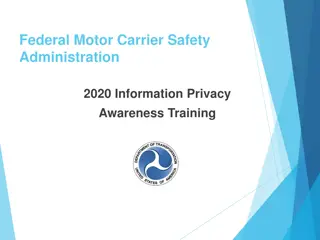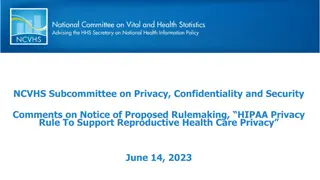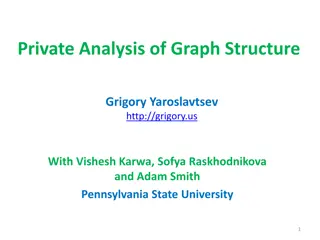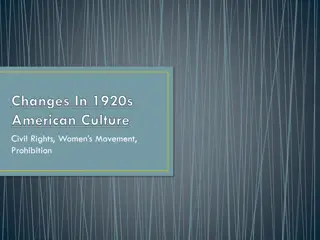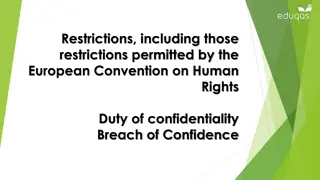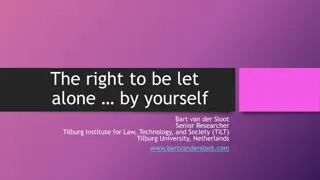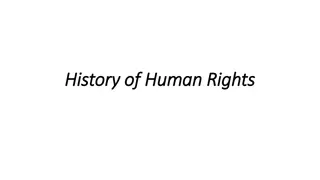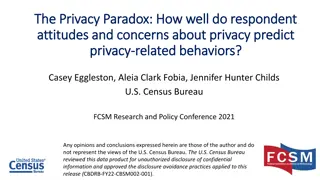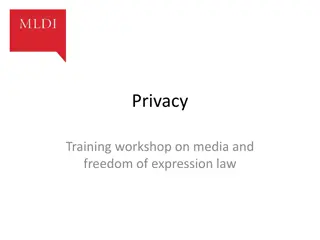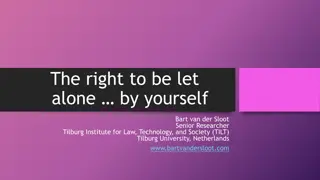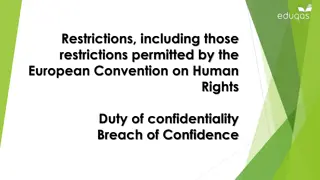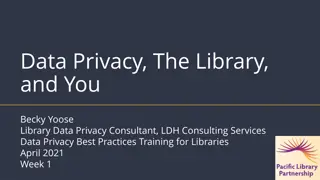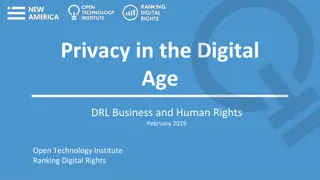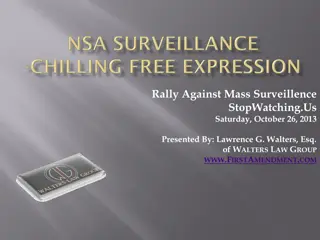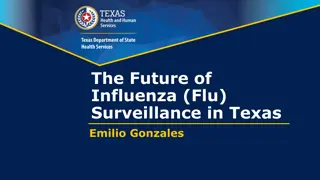State Surveillance and Privacy Rights
the history and implications of state surveillance, including restrictions and legal frameworks. Explore key questions about who conducts surveillance, its forms, admissibility of evidence, and the balance with the right to privacy. Delve into notable cases and legislative acts related to state surveillance practices.
Download Presentation

Please find below an Image/Link to download the presentation.
The content on the website is provided AS IS for your information and personal use only. It may not be sold, licensed, or shared on other websites without obtaining consent from the author.If you encounter any issues during the download, it is possible that the publisher has removed the file from their server.
You are allowed to download the files provided on this website for personal or commercial use, subject to the condition that they are used lawfully. All files are the property of their respective owners.
The content on the website is provided AS IS for your information and personal use only. It may not be sold, licensed, or shared on other websites without obtaining consent from the author.
E N D
Presentation Transcript
Restrictions, including those restrictions permitted by the European Convention on Human Rights Interception of communications Surveillance
Questions to consider In groups discuss the following: Who carries out surveillance? What forms can surveillance take? Who is likely to be subjected to surveillance? Should surveillance evidence be admissible in court? Surveillance v Right to Privacy?
History of State Surveillance Before 1985 no statutes regulating the use of state surveillance. Malone v MPC (1979) Malone v UK (1985) right to privacy (Art.8 of the European Convention on Human Rights) The response of the Government to the Malone case was to [pass the Interception of Communications Act 1985 - this has now been replaced by Pt. 1 of the Regulation of Investigatory Powers Act 2000
Police Act 1997 Before 1997 the use of bugging devices by the police was authorised only under administrative guidelines violation of principle in Entinck v Carrington(1765) executive power may not be exercised save where there is a legal basis for it The Supreme Court of Canada in Duarte(1990) said of surveillance techniques ..one can surely imagine a state activity more dangerous to individual privacy than electronic surveillance.
Police Act 1997 Khan (1996). Modelled on ICA 1985. Use of bugging is very broad Section 93(2) an authorisation may be issued if the action is expected to be of substantial value in the prevention and detection of serious crime and the objective cannot be achieved by other means. Serious crime = crimes of violence, crimes involving financial gain, those involving a large number of people with a common purpose; or the crime is one where a person over 21 could expect 3 years or more in prison.
Police Act 1997 Section 93(5) - authorisation for a warrant Chief Constable/ Assistant Chief Constable. Independent Commissioners appointed under section 91(1) must be notified as soon as warrants are granted section 96. Police can go ahead with the surveillance work. If Commissioner subsequently quashes the warrant then evidence must be destroyed and surveillance must cease.
Police Act 1997 In certain circumstances prior approval of the Commissioners is needed before surveillance can start s. 97 when do you think prior approval is needed? A dwelling. A bedroom in a hotel. Office premises.
Police Act 1997 When the Police Bill was going through Parliament 3 groups argued for exemption from the Act i.e. they could not be the subjects of bugging. Who do you think the 3 groups were? Lawyers Doctors Catholic priests There are NO exemptions under the ACT
Police Act 1997 Do you think the involvement of the Independent Commissioners provides oversight and scrutiny? Is this enough control over the actions of the police? Should the judiciary be involved in the authorisation process?
Regulation of Investigatory Powers Act 2000 Repeals the ICA 1985 Is the title misleading? Is there greater regulation under this Act? All forms of surveillance brought under it.
Regulation of Investigatory Powers Act 2000 S.1 makes it an offence to intentionally and without lawful authority to intercept communications by a postal service or telecommunications system This offence extends to voicemail messages, even after they have been accessed by the intended recipient - R v Edmondson (2013) An interception will be lawful if done with consent s.3 or with a warrant s. 5
Regulation of Investigatory Powers Act 2000 Authorisation is governed by ss 5 16 Power to issue a warrant lies with the Home Secretary Application for a warrant must come from one of a list of people specified in s.6 The warrant is only to be issued if the Home Secretary believes it is necessary for certain specified purposes set out in s.5 (3) and that the conduct authorised by the warrant is proportional to what is sought to be achieved by that conduct s. 5(2)
Regulation of Investigatory Powers Act 2000 The specified purposes set out in s.5 (3) are: The interests of national security; Preventing or detecting serious crime; Safeguarding the economic well-being of the UK; or Giving effect to an international mutual assistance agreement in circumstances equivalent to those falling within (b) a) b) c) d)
Regulation of Investigatory Powers Act 2000 Serious crime as outlined in (b) is defined in s.81(3) as: That the offence or one of the offences that is or would be constituted by the conduct is an offence for which a person who has attained the age of twenty-one and has no previous conviction could reasonably be expected to be sentenced to imprisonment for a term of three years or more; That the conduct involves the use of violence, results in substantial gain or is conduct by a large number of persons in pursuit of a common purpose a) b)
Regulation of Investigatory Powers Act 2000 S. 8 deals with the contents of the warrant it must specify the target, contain information about addresses etc. S.9 deals with the duration of the warrant the initial period is 3 months from issue, but it may be renewed an unlimited number of times, provided the Home Secretary continues to believe it is necessary.
Regulation of Investigatory Powers Act 2000 Supervision of the warrant system is by an independent Interception of Communications Commissioner The Commissioner is obliged to report annually to the Prime Minister The powers of the Commissioner are supervisory and do not extend to taking action in relation to particular warrants The only route of complaint for those dissatisfied with the system is to a Tribunal established under s.65
Regulation of Investigatory Powers Act 2000 S. 67 makes it clear that the Tribunal is to operate on the principles of judicial review , this means that its focus is more on procedure rather than substance If the Tribunal finds that there has been impropriety it has the power to quash a warrant, order the destruction of any information and to award compensation There is no further appeal from the Tribunal In 2010 the Tribunal received 164 complaints and upheld 6
Regulation of Investigatory Powers Act 2000 Covert surveillance this is now regulated by ss 26 - 48 of RIPA Surveillance is defined in s.487 to include: Monitoring, observing or listening to persons, their movements, their conversations or their other activities or communications; Recording anything monitored, observed, or listened to in the course of surveillance; and Surveillance by or with the assistance of a surveillance device. a) b) c)
Regulation of Investigatory Powers Act 2000 S.26 identified 3 types of behaviour that are covered by the Act: directed surveillance, intrusive surveillance and the conduct and use of covert human intelligence sources.
Regulation of Investigatory Powers Act 2000 Section 26intrusive surveillance covert surveillance which occurs when a device or an individual is actually present on residential premises or in a vehicle, or where it is carried out in relation to such premises or vehicle . if the device is not on the premises it is not intrusive unless the device consistently provides information of the same quality and detail as might be expected to be obtained from a device actually on premises or in a vehicle.
Regulation of Investigatory Powers Act 2000 Section 26 (2)covert but not intrusive surveillance is directed surveillanceif: it is undertaken for the purpose of a specific investigation and in order to obtain private information about a person . Section 26 (8) defines what is meant by a covert human intelligence source, such a source will establish or maintain a relationship with a person for the covert purpose of using the relationship to obtain access to information, or provide access to another, or for the covert purpose of disclosing information obtained from the relationship. Police actions in R v Hall (1994) and R v Stagg(1994) would clearly fall within this definition. Section 26 (8) is most likely to cover the actions of police informers.
Regulation of Investigatory Powers Act 2000 Authorisations are granted under ss 28 32 Section 28 & 29 Directed Surveillance may be authorised on the same grounds as those in the Police Act 1997, e.g. a superintendent can authorise , it must be necessary and proportionate and the grounds include national security and the economic well-being of the Uk, the crime to be prevented or detected does not have to be serious , and s,28 also includes public safety , public health and tax collection. Section 32 authorisations for intrusive surveillance are granted by the Secretary of State or senior authorising officers e.g. Chief Constables, requirements of necessity and proportionality apply but the grounds are limited to national security, the economic well-being of the Uk and serious crime Notice must be given to Surveillance Commissioner and authorisation will not take effect until it has been approved.
Evaluation of RIPA The procedures are an improvement on the situation prior to RIPA in that there is now a statutory framework for the operation of powers which almost be definition will involve infringements upon a person s privacy. However the control over the exercise of surveillance power by the Tribunal is vague; the exclusive jurisdiction of the Tribunal means that there is no appeal to the domestic courts from their decision, however appeal to the Strasbourg must be a strong possibility. Also for directed surveillance and the use of covert surveillance sources there is no involvement of the Surveillance Commissioners so therefore there is a lack of independent supervision. There are also problems as to whether individuals will be aware their rights have been infringed how will you know if surveillance is being carried out on you?
Investigatory Powers Act 2016 IPA 2016 brings together and updates existing powers (RIPA 2000 will continue until expressly repealed) The IPA introduces: a double-lock for the most intrusive powers, so that warrants issued by a Secretary of State will also require the approval of a senior judge new powers, and restated existing ones, for UK intelligence agencies and law enforcement to carry out targeted interception of communications, bulk collection of communications data, and bulk interception of communications a powerful new Investigatory Powers Commission, to oversee how the powers are usednew protections for journalistic and legally privileged material, and a requirement for judicial authorisation for acquisition of communications data that identify journalists sources harsh sanctions including the creation of new criminal offences for those misusing the powers
Evaluation Further Reforms needed has the IPA 2016 done enough? Should surveillance evidence be admissible in Court? Britain's security services fear that allowing intercept evidence to be used in a court of law would undermine its work - but globally the UK's stance on this issue is an exception. The US, Canada, New Zealand, Ireland, Australia, Hong Kong and South Africa all allow certain kinds of intercept evidence in their courts of law. Unlike the UK a judge and not a politician has the power to authorise telephone interception in all those countries, apart from in Ireland.
Evaluation Why is Britain reluctant to follow what other countries do? England has perhaps the first instance of interception being used in a court of law, when in 1586 Mary Queen of Scots was convicted of treason on the basis of intercepted mail. There is also a loophole in the law which allows taped conversations from prisons - mandatory for category A prisoners - to be used in evidence. Calls Soham killer Ian Huntley made to Maxine Carr and his mother were used to secure a conviction in 2003.
Independent oversight ALLOWING THE EVIDENCE Australia - Attorney General issues warrants for intelligence purposes, judge for serious crime investigations. Phone calls, e- mail and mail admissible. Canada - Must apply to judge, although police can intercept communications without a warrant on an emergency basis. Phone calls, e-mail and mail admissible. Hong Kong - A three-judge panel authorises and oversees the use of covert surveillance. Only mail is admissible. Ireland - Interceptions authorised by minister for justice, reviewed by high court judge. Phone calls, e-mail and mail admissible.
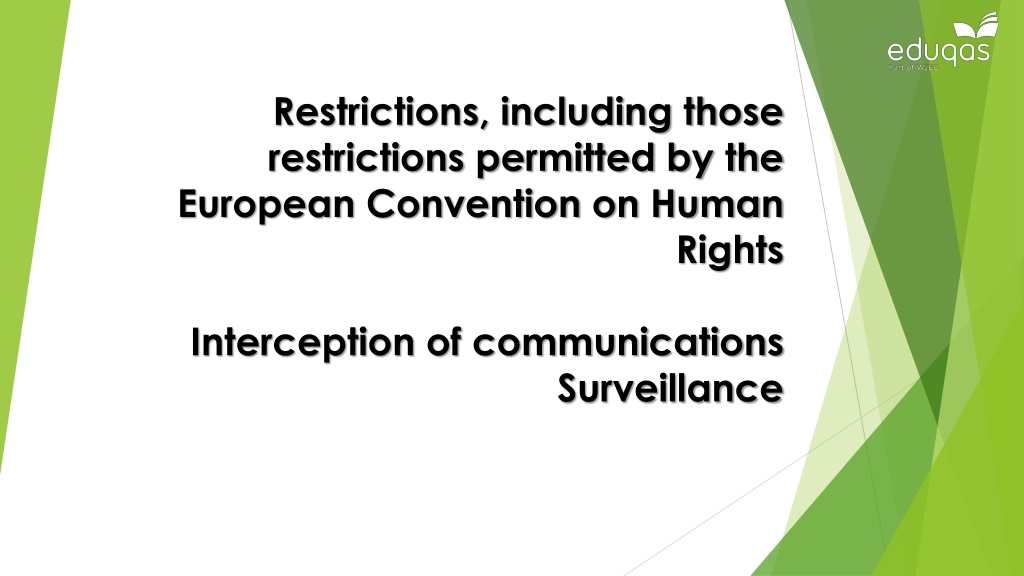
 undefined
undefined


